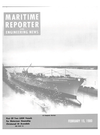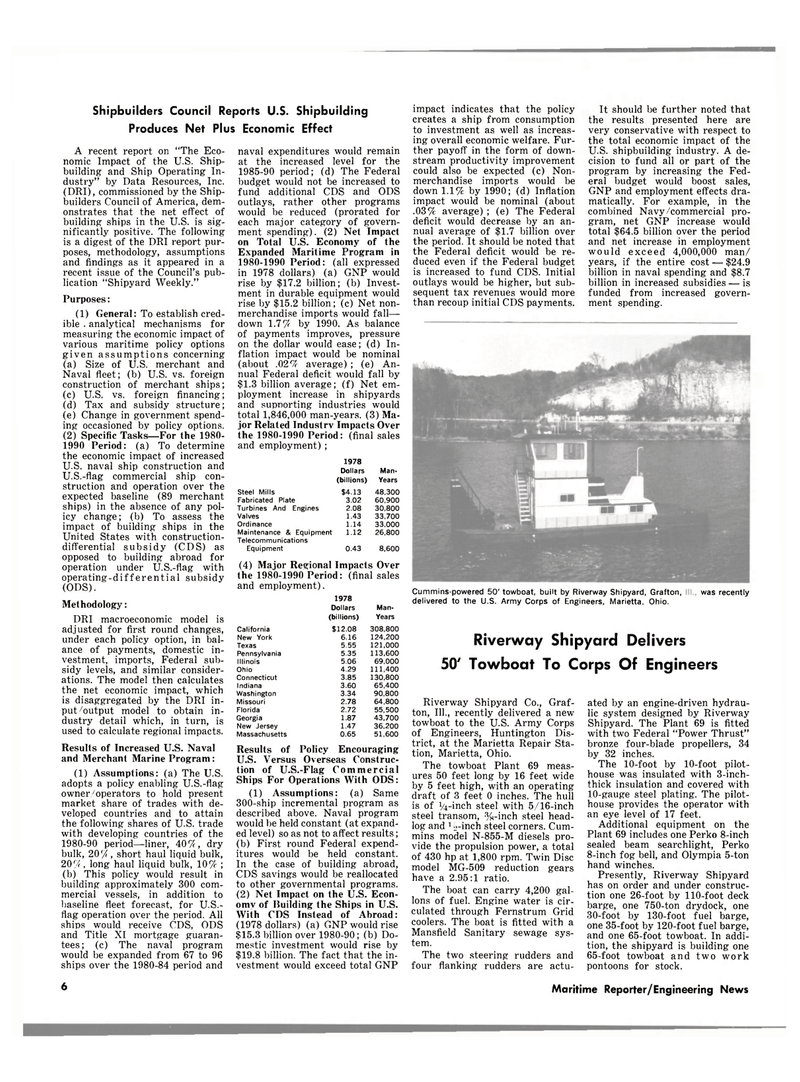
Page 4: of Maritime Reporter Magazine (February 15, 1980)
Read this page in Pdf, Flash or Html5 edition of February 15, 1980 Maritime Reporter Magazine
Shipbuilders Council Reports U.S. Shipbuilding
Produces Net Plus Economic Effect
A recent report on "The Eco- nomic Impact of the U.S. Ship- building and Ship Operating In- dustry" by Data Resources, Inc. (DRI), commissioned by the Ship- builders Council of America, dem- onstrates that the net effect of building ships in the U.S. is sig- nificantly positive. The following is a digest of the DRI report pur- poses, methodology, assumptions and findings as it appeared in a recent issue of the Council's pub- lication "Shipyard Weekly."
Purposes: (1) General: To establish cred- ible . analytical mechanisms for measuring the economic impact of various maritime policy options given assumptions concerning (a) Size of U.S. merchant and
Naval fleet; (b) U.S. vs. foreign construction of merchant ships; (c) U.S. vs. foreign financing; (d) Tax and subsidy structure; (e) Change in government spend- ing occasioned bv policy options. (2) Specific Tasks—For the 1980- 1990 Period: (a) To determine the economic impact of increased
U.S. naval ship construction and
U.S.-flag commercial ship con- struction and operation over the expected baseline (89 merchant ships) in the absence of any pol- icy change; (b) To assess the impact of building ships in the
United States with construction- differential subsidy (CDS) as opposed to building abroad for operation under U.S.-flag with operating-differential subsidy (ODS).
Methodology:
DRI macroeconomic model is adjusted for first round changes, under each policy option, in bal- ance of payments, domestic in- vestment, imports, Federal sub- sidy levels, and similar consider- ations. The model then calculates the net economic impact, which is disaggregated by the DRI in- put/output model to obtain in- dustry detail which, in turn, is used to calculate regional impacts.
Results of Increased U.S. Naval and Merchant Marine Program: (1) Assumptions: (a) The U.S. adopts a policy enabling U.S.-flag owner/operators to hold present market share of trades with de- veloped countries and to attain the following shares of U.S. trade with developing countries of the 1980-90 period—liner, 40%, dry bulk, 20%, short haul liquid bulk, 20%, long haul liquid bulk, 10% ; (b) This policy would result in building approximately 300 com- mercial vessels, in addition to baseline fleet forecast, for U.S.- flag operation over the period. All ships would receive CDS, ODS and Title XI mortgage guaran- tees; (c) The naval program would be expanded from 67 to 96 ships over the 1980-84 period and naval expenditures would remain at the increased level for the 1985-90 period; (d) The Federal budget would not be increased to fund additional CDS and ODS outlays, rather other programs would be reduced (prorated for each major category of govern- ment spending). (2) Net Impact on Total U.S. Economy of the
Expanded Maritime Program in 1980-1990 Period: (all expressed in 1978 dollars) (a) GNP would rise by $17.2 billion; (b) Invest- ment in durable equipment would rise by $15.2 billion; (c) Net non- merchandise imports would fall— down 1.77c by 1990. As balance of payments improves, pressure on the dollar would ease; (d) In- flation impact would be nominal (about .02% average) ; (e) An- nual Federal deficit would fall by $1.3 billion average; (f) Net em- ployment increase in shipyards and supnorting industries would total 1,846,000 man-years. (3) Ma- jor Related Tndustrv Impacts Over the 1980-1990 Period: (final sales and employment) ; 1978
Dollars Man- (billions) Years
Steel Mills
Fabricated Plate
Turbines And Engines
Valves
Ordinance
Maintenance & Equipment
Telecommunications
Equipment 3.02 2.08 1.43 1.14 1.12 0.43 1978
Dollars Man- (billions) Years
California $12.08 308,800
New York 6.16 124,200
Texas 5.55 121,000
Pennsylvania 5.35 113,600
Illinois 5.06 69,000
Ohio 4.29 111,400
Connecticut 3.85 130,800
Indiana 3.60 65,400
Washington 3.34 90,800
Missouri 2.78 64,800
Florida 2.72 55,500
Georgia 1.87 43,700
New Jersey 1.47 36,200
Massachusetts 0.65 51,600
Results of Policy Encouraging
U.S. Versus Overseas Construc- tion of U.S.-Flag Commercial
Ships For Operations With ODS: (1) Assumptions: (a) Same 300-ship incremental program as described above. Naval program would be held constant (at expand- ed level) so as not to affect results; (b) First round Federal expend- itures would be held constant.
In the case of building abroad,
CDS savings would be reallocated to other governmental programs. (2) Net Impact on the U.S. Econ- omv of Ruilding the Ships in U.S.
With CDS Instead of Abroad: (1978 dollars) (a) GNP would rise $15.3 billion over 1980-90; (b) Do- mestic investment would rise by $19.8 billion. The fact that the in- vestment would exceed total GNP impact indicates that the policy creates a ship from consumption to investment as well as increas- ing overall economic welfare. Fur- ther payoff in the form of down- stream productivity improvement could also be expected (c) Non- merchandise imports would be down 1.1% by 1990; (d) Inflation impact would be nominal (about .03% average) ; (e) The Federal deficit would decrease by an an- nual average of $1.7 billion over the period. It should be noted that the Federal deficit would be re- duced even if the Federal budget is increased to fund CDS. Initial outlays would be higher, but sub- sequent tax revenues would more than recoup initial CDS payments.
It should be further noted that the results presented here are very conservative with respect to the total economic impact of the
U.S. shipbuilding industry. A de- cision to fund all or part of the program by increasing the Fed- eral budget would boost sales,
GNP and employment effects dra- matically. For example, in the combined Navy/commercial pro- gram, net GNP increase would total $64.5 billion over the period and net increase in employment would exceed 4,000,000 man/ years, if the entire cost — $24.9 billion in naval spending and $8.7 billion in increased subsidies — is funded from increased govern- ment spending. $4.13 48.300 60,900 30,800 33,700 33,000 26,800 8,600 (4) Major Regional Impacts Over the 1980-1990 Period: (final sales and employment). Cummins-powered 50' towboat, built by Riverway Shipyard, Grafton, delivered to the U.S. Army Corps of Engineers, Marietta, Ohio. was recently
Riverway Shipyard Delivers 50' Towboat To Corps Of Engineers
Riverway Shipyard Co., Graf- ton, 111., recently delivered a new towboat to the U.S. Army Corps of Engineers, Huntington Dis- trict, at the Marietta Repair Sta- tion, Marietta, Ohio.
The towboat Plant 69 meas- ures 50 feet long by 16 feet wide by 5 feet high, with an operating draft of 3 feet 0 inches. The hull is of !/4-inch steel with 5/16-inch steel transom, %-inch steel head- log and 12-inch steel corners. Cum- mins model N-855-M diesels pro- vide the propulsion power, a total of 430 hp at 1,800 rpm. Twin Disc model MG-509 reduction gears have a 2.95:1 ratio.
The boat can carry 4,200 gal- lons of fuel. Engine water is cir- culated through Fernstrum Grid coolers. The boat is fitted with a
Mansfield Sanitary sewage sys- tem.
The two steering rudders and four flanking rudders are actu- ated by an engine-driven hydrau- lic system designed by Riverway
Shipyard. The Plant 69 is fitted with two Federal "Power Thrust" bronze four-blade propellers, 34 by 32 inches.
The 10-foot by 10-foot pilot- house was insulated with 3-inch- thick insulation and covered with 10-gauge steel plating. The pilot- house provides the operator with an eye level of 17 feet.
Additional equipment on the
Plant 69 includes one Perko 8-inch sealed beam searchlight, Perko 8-inch fog bell, and Olympia 5-ton hand winches.
Presently, Riverway Shipyard has on order and under construc- tion one 26-foot by 110-foot deck barge, one 750-ton drydock, one 30-foot by 130-foot fuel barge, one 35-foot by 120-foot fuel barge, and one 65-foot towboat. In addi- tion, the shipyard is building one 65-foot towboat and two work pontoons for stock. 56 ZIDELL Maritime Reporter/Engineering News

 3
3

 5
5
